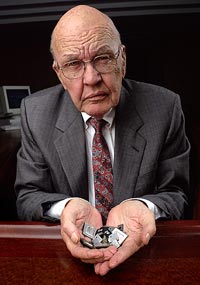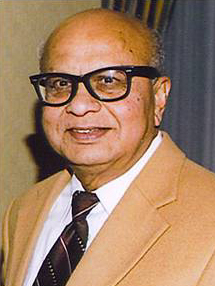
Jack St. Clair Kilby was an American electrical engineer who took part in the realization of the first integrated circuit while working at Texas Instruments (TI) in 1958. He was awarded the Nobel Prize in Physics on December 10, 2000. Kilby was also the co-inventor of the handheld calculator and the thermal printer, for which he had the patents. He also had patents for seven other inventions.

Robert Heath Dennard is an American electrical engineer and inventor.
Edmund O. Schweitzer III is an electrical engineer, inventor, and founder of Schweitzer Engineering Laboratories (SEL). Schweitzer launched SEL in 1982 in Pullman, Washington. Today, SEL manufacturers a wide variety of products that protect the electric power grid and industrial control systems at its five state-of-the-art U.S. manufacturing facilities in Pullman, Washington; Lewiston, Idaho; Lake Zurich, Illinois; West Lafayette, Indiana, and; Moscow, Idaho. SEL products and technologies are used in virtually every substation in North America and are in operation in 164 countries.

Yale Nance Patt is an American professor of electrical and computer engineering at The University of Texas at Austin. He holds the Ernest Cockrell, Jr. Centennial Chair in Engineering. In 1965, Patt introduced the WOS module, the first complex logic gate implemented on a single piece of silicon. He is a fellow of both the Institute of Electrical and Electronics Engineers and the Association for Computing Machinery, and in 2014 he was elected to the National Academy of Engineering.

A phasor measurement unit (PMU) is a device used to estimate the magnitude and phase angle of an electrical phasor quantity in the electricity grid using a common time source for synchronization. Time synchronization is usually provided by GPS or IEEE 1588 Precision Time Protocol, which allows synchronized real-time measurements of multiple remote points on the grid. PMUs are capable of capturing samples from a waveform in quick succession and reconstructing the phasor quantity, made up of an angle measurement and a magnitude measurement. The resulting measurement is known as a synchrophasor. These time synchronized measurements are important because if the grid’s supply and demand are not perfectly matched, frequency imbalances can cause stress on the grid, which is a potential cause for power outages.
Petar V. Kokotovic is professor emeritus in the College of Engineering at the University of California, Santa Barbara, USA. He has made contributions in the areas of adaptive control, singular perturbation techniques, and nonlinear control especially the backstepping stabilization method.
Arun N. Netravali is an Indian–American computer engineer credited with contributions in digital technology including HDTV. He conducted research in digital compression, signal processing and other fields. Netravali was the ninth President of Bell Laboratories and has served as Lucent's Chief Technology Officer and Chief Network Architect. He received his undergraduate degree from IIT Bombay, India, and an M.S. and a Ph.D. from Rice University in Houston, Texas, all in electrical engineering. Several global universities, including the Ecole Polytechnique Federale in Lausanne, Switzerland, have honored him with honorary doctorates.
Ashok Jhunjhunwala is an Indian academic and innovator. He received his B.Tech. from the Indian Institute of Technology, Kanpur and PhD from the University of Maine. He has been a faculty member at the Indian Institute of Technology Madras since 1981. He is currently holding the position of President of IIT Madras Research Park. During his career, he has contributed extensively to technology innovation and adoption in the Indian context.
James David Foley is an American computer scientist and computer graphics researcher. He is a Professor Emeritus and held the Stephen Fleming Chair in Telecommunications in the School of Interactive Computing at Georgia Institute of Technology. He was Interim Dean of Georgia Tech's College of Computing from 2008–2010. He is perhaps best known as the co-author of several widely used textbooks in the field of computer graphics, of which over 400,000 copies are in print and translated in ten languages. Foley most recently conducted research in instructional technologies and distance education.
The IEEE Nikola Tesla Award is a Technical Field Award given annually to an individual or team that has made an outstanding contribution to the generation or utilization of electric power. It is awarded by the Board of Directors of the IEEE. The award is named in honor of Nikola Tesla. This award may be presented to an individual or a team.
James S. Thorp was the head of the Bradley Department of Electrical and Computer Engineering at Virginia Tech. He was the Hugh P. and Ethel C. Kelly Professor Emeritus & Research Professor. He received all his degrees from Cornell University. Professor Thorp was a teacher, a researcher, and for many years served as the director, in the School of Electrical and Computer Engineering at Cornell, where he worked for 42 years, 1962-2004.
John O. Limb is an Australian engineer, known for fundamental contributions to the development of digital video communications and holder of a series of patents related to computer communications.

Dr. Mohammad Shahidehpour is a Carl Bodine Distinguished Professor and Chairman in the Electrical and Computer Engineering Department at Illinois Institute of Technology. He is the author of more than 300 technical papers and five books on electric power systems planning, operation, and control.

FNET is a wide-area power system frequency measurement system. Using a type of phasor measurement unit (PMU) known as a frequency disturbance recorder (FDR), FNET/GridEye is able to measure the power system frequency, voltage, and angle very accurately. These measurements can then be used to study various power system phenomena, and may play an important role in the development of future smart grid technologies. The FNET/GridEye system is currently operated by the Power Information Technology Laboratory at the University of Tennessee (UTK) in Knoxville, Tennessee, and Oak Ridge National Laboratory (ORNL) in Oak Ridge, Tennessee.
Bantval Jayant Baliga is an Indian electrical engineer best known for his work in power semiconductor devices, and particularly the invention of the insulated gate bipolar transistor (IGBT).

Bimal Kumar Bose, also known as B. K. Bose, is an electrical engineer, artificial intelligence researcher, scientist, educator, and currently a professor emeritus of power electronics in the Department of Electrical Engineering and Computer Science at the University of Tennessee, Knoxville.

Kurt E. Petersen is an American inventor and entrepreneur. He is known primarily for his work on microelectromechanical systems. Petersen was elected a member of the United States National Academy of Engineering in 2001.
Mohamed (Mo) El-Aref El-Hawary, was an Egyptian-born Canadian scientist of electric power system studies and the involvement of traditional/modern optimization algorithms, fuzzy systems, and artificial neural networks in their applications. El-Hawary was a mathematician, electrical engineer, computational intelligence researcher and professor of electrical and computer engineering at Dalhousie University.
Mangalore Anantha Pai was an Indian electrical engineer, academic and a Professor Emeritus at the University of Illinois at Urbana–Champaign. A former professor of electrical engineering at the Indian Institute of Technology, Kanpur, he is known for his contributions in the fields of power stability, power grids, large scale power system analysis, system security and optimal control of nuclear reactors and he has published 8 books and several articles. Pai is the first India born scientist to be awarded a PhD in Electrical Engineering from the University of California, Berkeley.

Md. Azizur (Aziz) Rahman was a Canadian Bangladeshi inventor of modern energy-efficient electric motors that span multiple industry applications. He was an electrical engineer, professor, researcher and scientist. He is internationally recognized as one of the founding innovators of modern power engineering and a pioneer in the development and application of interior permanent magnet motors and associated drive technology-used in the world's first mass-produced hybrid vehicle, the Toyota Prius. Since launching the Prius in 1997, Toyota surpassed global sales of 15 million hybrid vehicles in 2020, all of which use Dr. Rahman's IPM motor drive. His research contributions were broad and adopted in a wide range of electric motor applications ranging from vacuum cleaners, air conditioners, elevators to aircraft.









